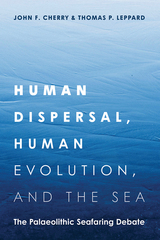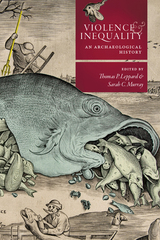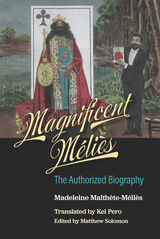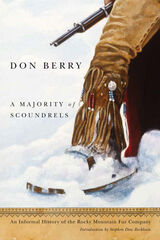2 books about Leppard, Thomas P.

Human Dispersal, Human Evolution, and the Sea
The Palaeolithic Seafaring Debate
John F. Cherry
University Press of Colorado, 2024
Human Dispersal, Human Evolution, and the Sea is the first book-length treatment of what has become known as the global Palaeolithic seafaring debate. Until recently, common consensus dictated that only in the last ten thousand years have humans routinely, permanently, and cross-culturally traversed seas and oceans to colonize new lands. New (and sometimes contentious) data from the Mediterranean and Island Southeast Asia challenge that consensus, suggesting to some researchers that long-distance voyaging is a behavior of great antiquity. These scholars suggest that oceans and seas facilitated and encouraged planetary dispersal in our own genus rather than acting as barriers to dispersal. If this model is correct, it necessitates a radical rethinking of not only the big patterns of human history but also more deeply our models of emergent human behavior and when the capacity for highly complex and coordinated group behaviors emerged.
Exploring the data in detail, the authors here show how a complex series of interrelated problems has tended to be treated in reductionist or overly simplistic terms. Cherry and Leppard elucidate this complexity by bringing to bear perspectives from archaeology, ecology, and evolutionary biology. They demonstrate not only that a series of unique circumstances—evolutionary, behavioral, environmental, and economic—conspired to drive mass, ubiquitous global colonization over the last ten millennia; but also that earlier, sparser data provide real insight into key social and behavioral thresholds, even if there is little evidence to support the “oceans as highways” model for species other than our own.
A major intervention in this important debate, Human Dispersal, Human Evolution, and the Sea explains the deep significance of the problem and the profound implications for history, archaeology, and biological anthropology, making it vital reading for students and scholars with interests in human dispersal and human evolution.
Exploring the data in detail, the authors here show how a complex series of interrelated problems has tended to be treated in reductionist or overly simplistic terms. Cherry and Leppard elucidate this complexity by bringing to bear perspectives from archaeology, ecology, and evolutionary biology. They demonstrate not only that a series of unique circumstances—evolutionary, behavioral, environmental, and economic—conspired to drive mass, ubiquitous global colonization over the last ten millennia; but also that earlier, sparser data provide real insight into key social and behavioral thresholds, even if there is little evidence to support the “oceans as highways” model for species other than our own.
A major intervention in this important debate, Human Dispersal, Human Evolution, and the Sea explains the deep significance of the problem and the profound implications for history, archaeology, and biological anthropology, making it vital reading for students and scholars with interests in human dispersal and human evolution.
[more]

Violence and Inequality
An Archaeological History
Thomas P. Leppard
University Press of Colorado, 2023
Violence and Inequality explores the deep-time archaeological relationship between violence and inequality, focusing on prehistoric archaeology’s contribution to the understanding of the human dynamics among coercive force, aggression, and the state. Detailed archaeological case studies within a strong theoretical framework built from historical studies consider the role of coercive violence in trajectories toward complexity, how levels and types of violence can be traced alongside emerging wealth disparities, and the social role of violence.
The assumption that violence and its threat buttressed elite social control is now challenged from various perspectives. This volume incorporates new models of the relationship between violence and social inequalities into the archaeology of social complexity, building more complicated and nuanced understandings of how different modes of social violence can militate different types of social constitution. Contributions from a variety of methodological angles—such as the bioarchaeology of health and trauma and radiogenic isotope studies and the aesthetics of violence—use a comparative perspective, drawing on data from the Southwestern US, Bronze Age China, early dynastic Egypt, ancient Mesopotamia, Roman Britain, and the Andes.
Violence and Inequality offers an original and deep history of violence and inequality. Understanding the long-term intersection of violence and inequality and how they support or erode one another is of intrinsic importance, making this work significant to the study of archaeology, economic history, and collective action.
The assumption that violence and its threat buttressed elite social control is now challenged from various perspectives. This volume incorporates new models of the relationship between violence and social inequalities into the archaeology of social complexity, building more complicated and nuanced understandings of how different modes of social violence can militate different types of social constitution. Contributions from a variety of methodological angles—such as the bioarchaeology of health and trauma and radiogenic isotope studies and the aesthetics of violence—use a comparative perspective, drawing on data from the Southwestern US, Bronze Age China, early dynastic Egypt, ancient Mesopotamia, Roman Britain, and the Andes.
Violence and Inequality offers an original and deep history of violence and inequality. Understanding the long-term intersection of violence and inequality and how they support or erode one another is of intrinsic importance, making this work significant to the study of archaeology, economic history, and collective action.
[more]
READERS
Browse our collection.
PUBLISHERS
See BiblioVault's publisher services.
STUDENT SERVICES
Files for college accessibility offices.
UChicago Accessibility Resources
home | accessibility | search | about | contact us
BiblioVault ® 2001 - 2024
The University of Chicago Press









